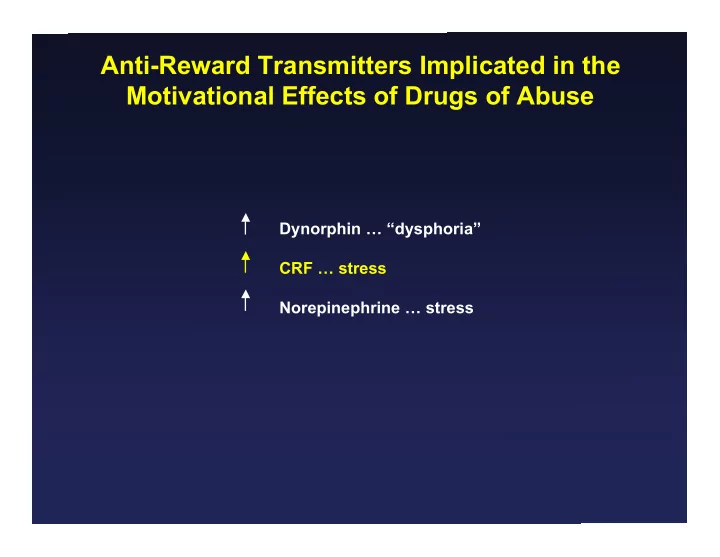

Anti-Reward Transmitters Implicated in the Motivational Effects of Drugs of Abuse Dynorphin … “dysphoria” CRF … stress Norepinephrine … stress
CNS Actions of Corticotropin-Releasing Factor (CRF)
Major CRF-Immunoreactive Cell Groups and Fiber Systems in the Rat Brain From: Swanson LW, Sawchenko PE, Rivier J and Vale W, Neuroendocrinology, 1983, 36:165-186.
CRF Produces Arousal, Stress-like Responses, and a Dysphoric, Aversive State Paradigm CRF Agonist CRF Antagonist Acoustic startle Facilitates startle Blocks fear-potentiated startle Suppresses exploration Reverses suppression of exploration Elevated plus maze Defensive burying Enhances burying Reduces burying Fear conditioning Induces conditioned fear Blocks acquisition of conditioned fear Cued electric shock Enhances freezing Attenuates freezing Taste / Place Conditioning Produces place aversion Weakens drug-induced place aversion
Sampling of Interstitial Neurochemicals Sampling of Interstitial Neurochemicals by in vivo Microdialysis by in vivo Microdialysis • Allows sampling of neurochemicals in conscious animals (correlate brain chemistry with behavior). • Implanted so that semi-permeable probe tip is in specific brain region of interest. • Substances below the membrane MW cutoff diffuse across membrane based on concentration gradient. • Both neurochemical sampling and localized drug delivery are possible. Collaborators: Dr. Friedbert Weiss, Dr. Larry Parsons, Dr. Emilio Merlo-Pich, Dr. Regina Richter
Withdrawal-induced Increases in Extracellular Levels of CRF
Pieter Bruegel
Rodent Model of Excessive Drinking During Withdrawal Self-administration Dependence Withdrawal from alcohol training induction vapors Negative emotional state: • Anxiety-like behavior • Reward threshold deficits • Increased CRF release in the extended amygdala Excessive drinking: Sweetened solution fading used Chronic intermittent alcohol • 2-3 fold higher alcohol intake to train animals to lever press for: vapors (4+ wks) • Increased progressive ratio breakpoints 10%w/v EtOH vs Water Target blood alcohol levels • Relapse following prolonged (BALs): 0.125-0.250 g% abstinence Roberts AJ, Cole M and Koob GF, Alcohol Clin Exp Res, 1996, 20:1289-1298. Methods Roberts AJ, Heyser CJ, Cole M, Griffin P and Koob GF, Neuropsychopharmacology, 2000, 22:581-584. from: O’Dell LE, Roberts AJ, Smith RT and Koob GF, Alcohol Clin Exp Res, 2004, 28:1676-1682.
CRF 1 Antagonist MPZP Decreases Excessive Ethanol Self-administration during Withdrawal (30 min session 6 h into withdrawal) From: Richardson HN, Funk C, Grant Y, Zorrilla EP and Koob GF, 2008,Pharmacology, Biochemistry and Behavior 88: 497-510
CRF Antagonist D-Phe-CRF 12-41 in Central Nucleus of the Amygdala Decreases Ethanol Self-Administration During Withdrawal in Wistar Rats (30 min session 2 h into withdrawal) From: Funk C, O’Dell LE and Koob GF,2006 J. Neuroscience 26:11324-11332.
Existing and Future Medications for Addiction: Withdrawal/Negative Affect Stage Existing medications Future targets • methadone • GABA modulators (homeostatic resetters) • buprenorphine • CRF 1 antagonists (stress reducers) • varenicline • κ opioid antagonists (dysphoria reducer) • nicotine patch
Preoccupation/Anticipation “Craving” Stage
Reward Craving-Type 1 • “Craving”- induced by stimuli that have been paired with drug self- administration such as environmental cues • An animal model of craving- type 1 is cue induced reinstatement where a cue previously paired with access to drug reinstates responding for a lever that has been extinguished. • Neurobiological substrates include glutamatergic projections from medial prefrontal cortex and basolateral amygdala to nucleus accumbens
Relief Craving-Type 2 • State of protracted abstinence in subjects with addiction or alcoholism weeks after acute withdrawal. • Conceptualized as a state change characterized by anxiety and dysphoria or a residual negative emotional state that combines with Craving-Type 1 situations to produce relapse to excessive drug taking • Animal models of Craving-Type 2 include stress-induced reinstatement and increased drug taking in animals during protracted abstinence • Neurobiological substrates include residual activation of brain stress systems including corticotropin releasing factor and norepinephrine in the extended amygdala
Existing and Future Medications for Addiction: Preoccupation/Anticipation “Craving” Stage Existing medications Future targets • acamprosate • GABA modulators (homeostatic resetters) • buproprion • CRF 1 antagonists (stress reducers) • Glutamate modulators (habit reducers)
Stress and Anti-stress Neurotransmitters Implicated in the Motivational Effects of Drugs of Abuse Corticotropin-releasing factor ↑ Neuropeptide Y ↓ ↑ Norepinephrine ↓ Nociceptin (orphanin FQ) ↑ Vasopressin Orexin (hypocretin) ↑ ↑ Dynoprhin ↑ Substance P
Brain Arousal-Stress System Modulation in the Extended Amygdala From: Koob, G.F. 2008 Neuron 59:11-34
Non-dependent Dependent Positive Positive Reinforcement Reinforcement Negative Negative Reinforcement Reinforcement
Targets from the “Dark Side” for Medications Development Derived from Preclinical Basic Research Class Target Dopamine receptor partial agonists D 2 receptor partial agonist (aripiprazole) D 3 receptor partial agonist Modulators of γ -aminobutyric acid Gabapentin Modulators of brain stress systems CRF 1 receptor antagonist Dynorphin antagonist Neurokinin-1 receptor antagonist From: Koob GF, Lloyd GK, Mason BJ. Nat Rev Drug Discov, 2009, 8:500-515.
Key Findings and Conclusions The neurochemical substrates for the acute reinforcing effects of drugs of abuse in the binge/ intoxication stage — includes opioid peptides and dopamine in the ventral striatum of the basal forebrain. The role of reward and brain stress systems in the withdrawal/negative affect stage for all major drugs of abuse — includes decreases in reward function, increases in stress-like responses and increases in CRF in the amygdala that are of motivational significance The neurochemical and neuroanatomical substrates for the preoccupation/anticipation (“craving”) stage of addiction cycle)-- involves a significant glutamate system dysregulation and a brain stress component also mediated by CRF systems in the extended amygdala The basis for compulsive drug use associated with dependence — includes not only loss of function of reward systems but recruitment of brain stress systems such as corticotropin releasing factor, norepinephrine and dynorphin in the extended amygdala Novel treatments for compulsive use that can derived from our understanding of the neurobiological basis of emotional dysregulation during withdrawal and protracted abstinence: corticotropin releasing factor, dynorphin, substance P, norepinephrine, vasopressin, orexin (hypocretin), neuropeptide Y,nociceptin
Recommend
More recommend